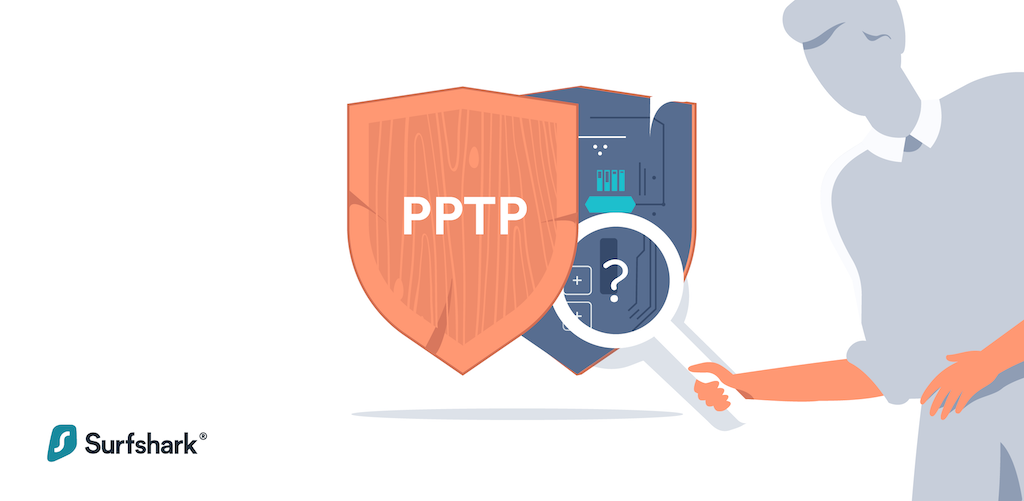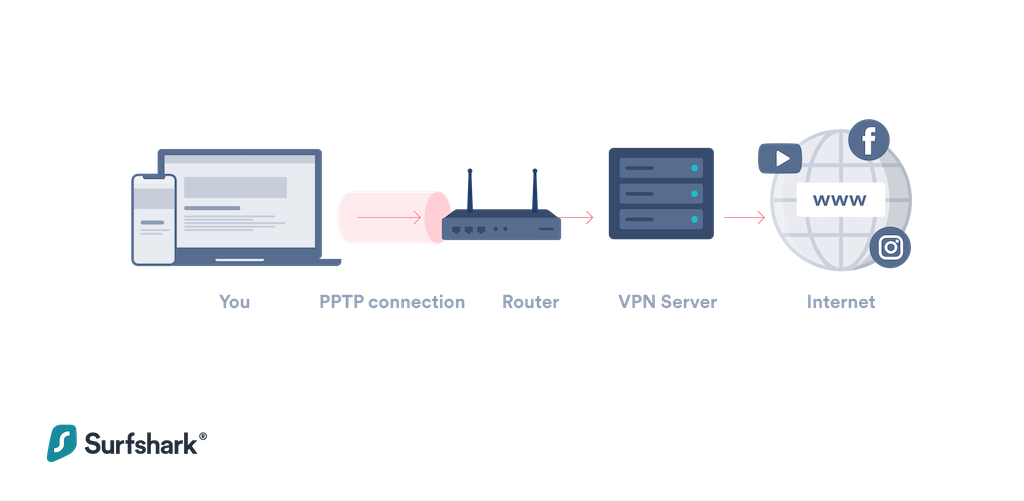What is a PPTP VPN and why it’s the wrong choice
Aside from its lack of security, the protocol also struggles to bypass firewalls and can have compatibility issues with routers.
What is PPTP (Point-to-Point Tunneling Protocol)?
Point-to-Point Tunneling (PPTP) is one of the oldest VPN protocols that was widely used for creating secure, encrypted tunnels in the early 2000s. Developed by Microsoft in 1999, the point-to-point protocol presented an easy and effective way to encrypt communications. Let’s review the PPTP VPN protocol to understand its advantages and limitations.
Feb 04, 2021
Время чтения: 7 мин.
- What is PPTP?
- How PPTP works
- What are the advantages and disadvantages of the PPTP?
- What is PPTP passthrough?
- How does a PPTP connection compare to other protocols?
- Is PPTP secure to use?
What is PPTP?
The Point-to-Point Tunneling Protocol is the first networking protocol used for creating virtual private networks. At a glance, the PPTP offers everything most VPN protocols have, including authentication, VPN tunnel establishment, and data encryption.
However, despite being widely used in the nineties, the PPTP VPN protocol doesn’t live up to modern-day VPN technologies. It has significant security issues, making it vulnerable to certain types of attacks (e.g., bit-flipping). Let’s look at how it works to better understand where the security issues lie.
How PPTP works
As with all tunneling protocols, PPTP specifically builds a tunnel between two points. Once the PPTP connection is established, all data packets passed through are wrapped in an IP envelope and then sent to another router or machine, which will treat the data like an IP packet. It’s then decrypted and made accessible to the receiving party.
PPTP can handle two types of data flow: data packets and control messages. The control messages are made for managing the start and end of the encrypted connection. It’s a simple process that has been expanded upon and improved by every VPN protocol created since.
What are the advantages and disadvantages of the PPTP?
The PPTP doesn’t offer the strongest security, but it is relatively fast and easy to set up. Let’s look at the pros and cons of PPTP in more detail.
PPTP advantages
The PPTP VPN protocol is a simple and fast solution, making it a good choice for those prioritizing speed and efficiency. Here are the main pros of the Point-to-Point Tunneling Protocol.
- Easy to set up. Setting up a PPTP VPN is quick and simple, making it accessible to people without technical knowledge.
- Compatible with various operating systems. Because the Point-to-Point Tunneling Protocol is one of the oldest VPN protocols, it is widely supported by most operating systems (including Windows, macOS, and Linux).
- Speed and performance. The PPTP doesn’t have complex encryption processes, which is a security issue. However, because of the lack of complicated encryption and authentication processes, the PPTP delivers faster connection speeds and better performance.
PPTP disadvantages
Despite the ease of setting up and the fast speeds, point-to-point tunneling fails to deliver in the most important area — VPN security. Let’s review its main disadvantages.
- Weak security. The PPTP is no longer considered a secure VPN protocol. It doesn’t have adequate security measures, particularly when it comes to encryption. The PPTP uses Microsoft Point-to-Point Encryption (MPPE) with outdated algorithms vulnerable to cyberattacks. The most significant security vulnerability of the PPTP is that it relies on short encryption keys. The shorter the keys, the more susceptible the encryption to brute-force attacks.
- Poor authentication. The PPTP has countless authentication vulnerabilities. It uses a method called the Microsoft Challenge Handshake Authentication Protocol (MS-CHAP) for user authentication, which has many weaknesses and can be exploited in many ways.
- Firewall restrictions. Firewalls are security mechanisms that control and filter network traffic based on predefined rules. Because the PPTP lacks standardized VPN port numbers, it can easily get blocked by firewalls, leading to connectivity issues.
What is a PPTP VPN and why it’s the wrong choice
Point-to-Point Tunneling Protocol (PPTP) is one of many remote network connection implementation methods for VPNs . A PPTP VPN receives data, encrypts it, and transmits it over the internet. Easy to set up, PPTP is one of the oldest VPN protocols used by more advanced users in very niche cases. Then again, due to its age, PPTP encryption is terrible at fulfilling its essential security function – protecting user information. But let’s elaborate on that.
Table of contents
How a PPTP VPN works
At a glance, PPTP carries out the same basic operations as most other VPN protocols – authentication, tunnel establishment , data encryption/encapsulation, and transportation.
Simply put, PPTP security is creating a tunnel between two points, usually the user’s device and a remote network. It’s all done using a set of predetermined rules and procedures called a protocol.
This link is then used to transfer encrypted information back and forth between the two points, which in theory should make a safe VPN connection. However, PPTP VPN’s authentication and encryption methods are extremely outdated and have severe security flaws.
Why a PPTP connection is considered obsolete
PPTP is a direct predecessor of PPP, an even older Point-to-Point Protocol, and is built on its outdated framework. It can use three authentication protocols, two out of which (PAP and CHAP) are known to have been breached and exploited before, and only supports MPPE (Microsoft Point-to-Point Encryption) encryption keys of up to 128 bits.
128-bit keys are usually not that easy to crack, but MPPE is infamous for being extra vulnerable to bit-flipping attacks. In fact, the NSA was allegedly able to crack and bypass it , which allowed them to monitor PPTP users’ online activity.
Aside from its lack of security, the protocol also struggles to bypass firewalls and can have compatibility issues with routers.
A PPTP VPN benefits
Ironically, however, PPTP’s downfalls are also its only saving grace – bad encryption means small overhead, which directly increases speed. So because of its abysmal security, a PPTP VPN remains, by a small margin , one of the faster VPN protocols to date.
It is also easy to set up, which, when paired with its speed, might make it seem like a viable VPN protocol.
PPTP in a nutshell:
- Easy to set up
- Very fast In-built
- Windows compatibility
- Poor authentication method availability
- Outdated and obsolete encryption
- Requires the PPTP Passthrough feature for the router
- Easily blocked by firewalls



